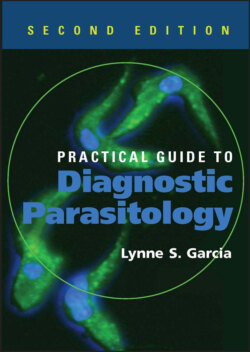Читать книгу Practical Guide to Diagnostic Parasitology - Lynne Shore Garcia - Страница 81
На сайте Литреса книга снята с продажи.
Formalin
ОглавлениеFormalin is an all-purpose fixative that is appropriate for helminth eggs and larvae and for protozoan cysts. Two concentrations are commonly used: 5%, which is recommended for preservation of protozoan cysts, and 10%, which is recommended for helminth eggs and larvae. Although 5% is often recommended for all-purpose use, most commercial manufacturers provide 10%, which is more likely to kill all helminth eggs. To help maintain organism morphology, the formalin can be buffered with sodium phosphate buffers, i.e., neutral formalin. Selection of specific formalin formulations is at the user’s discretion. Aqueous formalin permits examination of the specimen as a wet mount only, a technique much less accurate than a stained smear for the identification of intestinal protozoa. The most common preparation is 10% formalin, prepared as follows:
Formaldehyde (USP) . . . . . . . . . . . . . 100 ml (or 50 ml for 5%)
Saline solution, 0.85% NaCl . . . . . 900 ml (or 950 ml for 5%)
Dilute 100 ml of formaldehyde with 900 ml of 0.85% NaCl solution. (Distilled water may be used instead of saline solution.)
Note: Formaldehyde is normally purchased as a 37 to 40% HCHO solution; however, for dilution it should be considered to be 100%.
If you want to use buffered formalin, the recommended approach is to mix thoroughly 6.10 g of Na2HPO4 and 0.15 g of NaH2PO4 and store the dry mixture in a tightly closed bottle. For 1 liter of either 10 or 5% formalin, 0.8 g of the buffer salt mixture should be added.
Protozoan cysts (not trophozoites), coccidian oocysts, microsporidian spores, and helminth eggs and larvae are well preserved for long periods in 10% aqueous formalin. Hot (60°C) formalin can be used for specimens containing helminth eggs, since in cold formalin some thick-shelled eggs may continue to develop, become infective, and remain viable for long periods; however, this approach is not practical for routine clinical laboratories. Several grams of fecal material should be thoroughly mixed in 5 or 10% formalin.
Summary: Formalin
